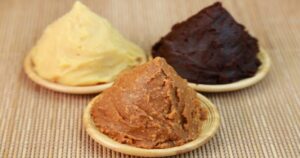Miso soup may seem simple, but it’s a deeply rich and traditional Japanese dish.
I wanted to teach my daughter how to make it, so I opened up my old Japanese cooking textbooks and put together this guide ♪
At the end, I’ve also included a timeless piece of advice from a Japanese culinary teacher — a “secret tip” for making truly delicious miso soup. Don’t miss it!
 Ponkuma
PonkumaLet’s learn how to make delicious miso soup together!
Miso Soup Recipe (Serves 2)
Ingredients
| Ingredient | Amount |
|---|---|
| Dashi stock | 300–400 ml |
| Miso | 1 tbsp (about 18g) |
| (For white miso: 1.5 tbsp / about 25g) | — |
| Add-ins (optional) | As you like |
Classic add-ins: Tofu, wakame seaweed, green onion, aburaage (fried tofu), shimeji mushrooms
Root veggies: Potato, daikon, carrot, turnip, burdock
Other tasty options: Onion, cabbage, spinach, napa cabbage, maitake mushrooms, sweet potato, etc.
Looking for dashi powder?
\Highly nutritious and recommended!/
Instructions
- Cut all ingredients ahead of time.
- Prepare dashi in a pot.
- (Don’t add miso yet. If using granulated dashi, add half now and half at the end to preserve flavor.)
- Add firm vegetables like carrots, potatoes, burdock, or daikon to the cold dashi and bring to a boil. Cook until tender.
- (Adding oil-removed aburaage at this stage adds a nice richness.)
- Once vegetables are cooked, turn off the heat and stir in the miso.
- ⚠️ Important: Do not boil after adding miso — it will lose its aroma and flavor.
- Add quick-cooking ingredients (tofu, wakame, nameko, greens, etc.) and gently heat through.
- Just before boiling, add aromatic toppings like chopped green onions or mitsuba, and turn off the heat.
- Add optional final flavorings such as grated ginger, yuzu zest, shichimi spice, or sesame seeds if desired.



固い野菜ってどれくらい煮る必要があるの?



野菜の切り方によって、火の通り方や煮る時間が変わってくるよ



え?でも…
全然わかんないの…



最初のうちは、自分で味見して確認してみるといいよ!
そうすることで、切り方と煮る時間の“ちょうどよさ”がわかるようになるんだよ!
- After Adding Miso:Never boil! It ruins the aroma and taste.
- Dashi Types:You can use niboshi (dried sardines) or “second dashi” too.
- Granulated Dashi:Use half at the beginning, half at the end for best flavor.
- From cold dashi: Root veggies (carrot, daikon, potato), pumpkin, onion, aburaage
- Before adding miso: Mushrooms
- Right after miso: Tofu, wakame, nameko, greens, fu (rehydrated wheat gluten)
- Right before turning off heat: Green onions, mitsuba
- Strong flavors (fish, mushrooms): Red miso
- Light flavors (tofu, veggies): White miso
- You can also mix miso types to adjust flavor depending on your mood or the season.
- Summer: Use more red miso for a refreshing finish
- Winter: Use more white miso for a mellow taste
Delicious Miso Soup = Delicious ????
A long time ago, a Japanese cooking instructor once said:
“The secret to delicious miso soup lies almost entirely in choosing the right miso.”
It’s a simple phrase — but one that stays with you.



I want to know what kind of miso is really tasty…



Right? I thought the same!
So I did some research on the best miso — take a look if you’re curious ♪




